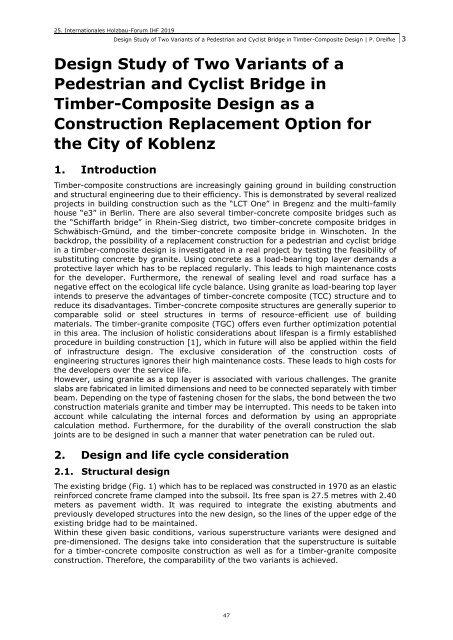25. Internationale Holzbau-Forum (IHF 2019) - Band III
Erfolgreiche ePaper selbst erstellen
Machen Sie aus Ihren PDF Publikationen ein blätterbares Flipbook mit unserer einzigartigen Google optimierten e-Paper Software.
<strong>25.</strong> <strong>Internationale</strong>s <strong>Holzbau</strong>-<strong>Forum</strong> <strong>IHF</strong> <strong>2019</strong><br />
Design Study of Two Variants of a Pedestrian and Cyclist Bridge in Timber-Composite Design | P. Dreifke 3<br />
Design Study of Two Variants of a<br />
Pedestrian and Cyclist Bridge in<br />
Timber-Composite Design as a<br />
Construction Replacement Option for<br />
the City of Koblenz<br />
1. Introduction<br />
Timber-composite constructions are increasingly gaining ground in building construction<br />
and structural engineering due to their efficiency. This is demonstrated by several realized<br />
projects in building construction such as the “LCT One” in Bregenz and the multi-family<br />
house “e3” in Berlin. There are also several timber-concrete composite bridges such as<br />
the “Schiffarth bridge” in Rhein-Sieg district, two timber-concrete composite bridges in<br />
Schwäbisch-Gmünd, and the timber-concrete composite bridge in Winschoten. In the<br />
backdrop, the possibility of a replacement construction for a pedestrian and cyclist bridge<br />
in a timber-composite design is investigated in a real project by testing the feasibility of<br />
substituting concrete by granite. Using concrete as a load-bearing top layer demands a<br />
protective layer which has to be replaced regularly. This leads to high maintenance costs<br />
for the developer. Furthermore, the renewal of sealing level and road surface has a<br />
negative effect on the ecological life cycle balance. Using granite as load-bearing top layer<br />
intends to preserve the advantages of timber-concrete composite (TCC) structure and to<br />
reduce its disadvantages. Timber-concrete composite structures are generally superior to<br />
comparable solid or steel structures in terms of resource-efficient use of building<br />
materials. The timber-granite composite (TGC) offers even further optimization potential<br />
in this area. The inclusion of holistic considerations about lifespan is a firmly established<br />
procedure in building construction [1], which in future will also be applied within the field<br />
of infrastructure design. The exclusive consideration of the construction costs of<br />
engineering structures ignores their high maintenance costs. These leads to high costs for<br />
the developers over the service life.<br />
However, using granite as a top layer is associated with various challenges. The granite<br />
slabs are fabricated in limited dimensions and need to be connected separately with timber<br />
beam. Depending on the type of fastening chosen for the slabs, the bond between the two<br />
construction materials granite and timber may be interrupted. This needs to be taken into<br />
account while calculating the internal forces and deformation by using an appropriate<br />
calculation method. Furthermore, for the durability of the overall construction the slab<br />
joints are to be designed in such a manner that water penetration can be ruled out.<br />
2. Design and life cycle consideration<br />
2.1. Structural design<br />
The existing bridge (Fig. 1) which has to be replaced was constructed in 1970 as an elastic<br />
reinforced concrete frame clamped into the subsoil. Its free span is 27.5 metres with 2.40<br />
meters as pavement width. It was required to integrate the existing abutments and<br />
previously developed structures into the new design, so the lines of the upper edge of the<br />
existing bridge had to be maintained.<br />
Within these given basic conditions, various superstructure variants were designed and<br />
pre-dimensioned. The designs take into consideration that the superstructure is suitable<br />
for a timber-concrete composite construction as well as for a timber-granite composite<br />
construction. Therefore, the comparability of the two variants is achieved.<br />
47

















